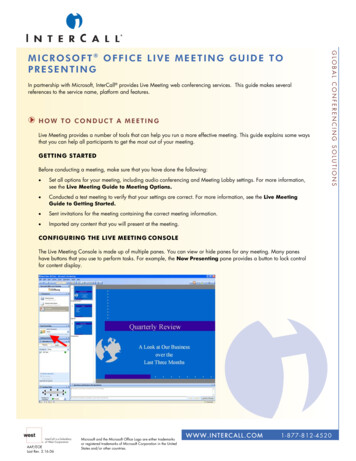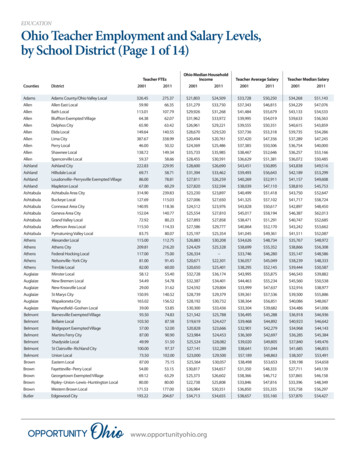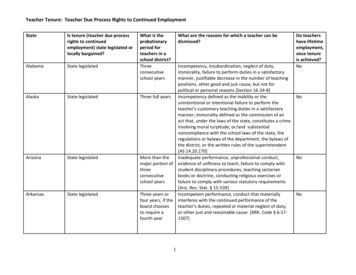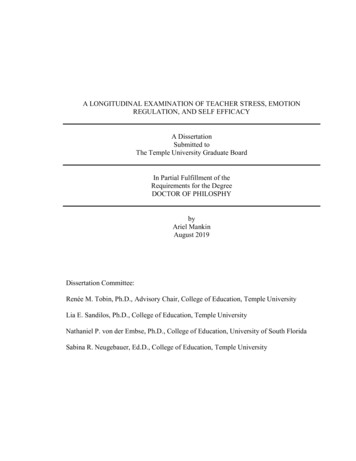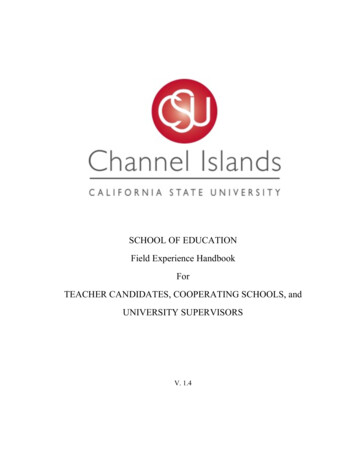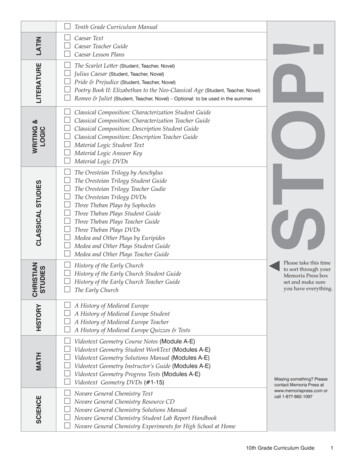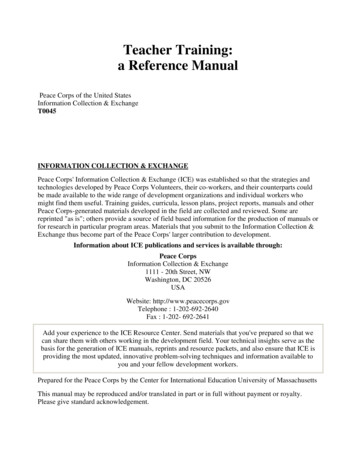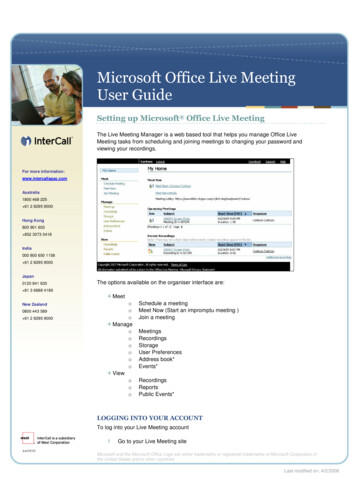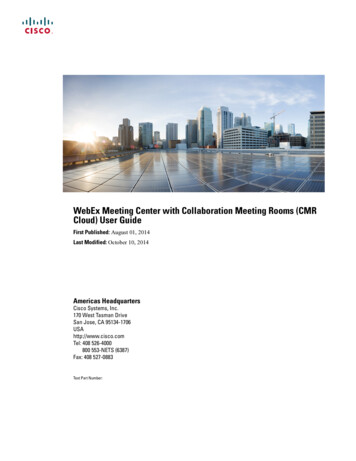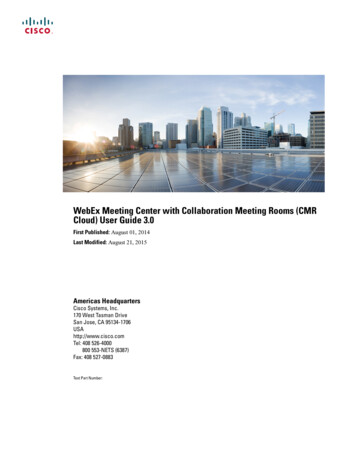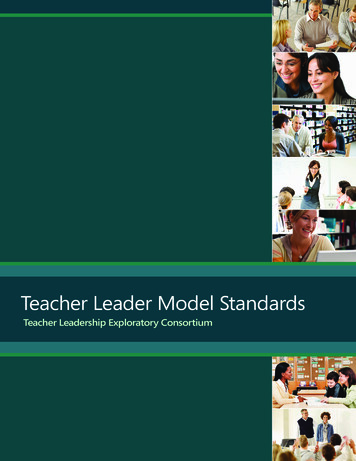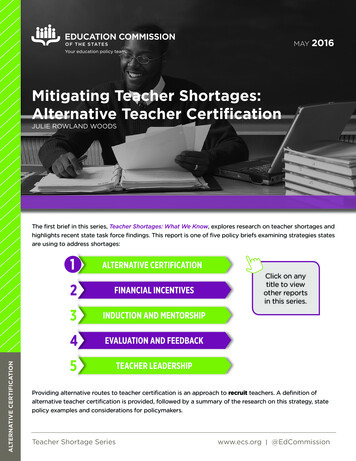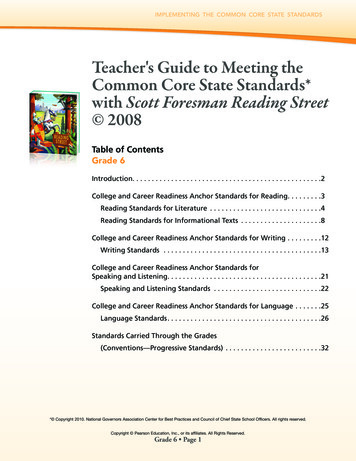
Transcription
Implementing the Common Core State StandArdsTeacher's Guide to Meeting theCommon Core State Standards*with Scott Foresman Reading Street 2008Table of ContentsGrade 6Introduction . . . . . . . . . . . . . . . . . . . . . . . . . . . . . . . . . . . . . . . . . . . . . . . . 2College and Career Readiness Anchor Standards for Reading . . . . . . . . 3Reading Standards for Literature . . . . . . . . . . . . . . . . . . . . . . . . . . . . . 4Reading Standards for Informational Texts . . . . . . . . . . . . . . . . . . . . . 8College and Career Readiness Anchor Standards for Writing . . . . . . . . . 12Writing Standards . . . . . . . . . . . . . . . . . . . . . . . . . . . . . . . . . . . . . . . . . 13College and Career Readiness Anchor Standards forSpeaking and Listening . . . . . . . . . . . . . . . . . . . . . . . . . . . . . . . . . . . . . . . 21Speaking and Listening Standards . . . . . . . . . . . . . . . . . . . . . . . . . . . . 22College and Career Readiness Anchor Standards for Language . . . . . . . 25Language Standards . . . . . . . . . . . . . . . . . . . . . . . . . . . . . . . . . . . . . . . 26Standards Carried Through the Grades(Conventions—Progressive Standards) . . . . . . . . . . . . . . . . . . . . . . . . . 32* Copyright 2010. National Governors Association Center for Best Practices and Council of Chief State School Officers. All rights reserved.Copyright Pearson Education, Inc., or its affiliates. All Rights Reserved.Grade 6 Page 1
IntroductionThe Pearson PromiseWelcome to the Common Core State Standards. As the largest educationalpublishing company in the world, Pearson is committed to providing you withcurriculum that not only meets these new guidelines, but also supports yourimplementation of these standards with your students.Pearson has aligned the Common Core State Standards to every grade levelof Scott Foresman Reading Street, our premier educational curriculum. Thiscorrelation provides an alignment of the Common Core State Standards tothe Grade 6 content in Scott Foresman Reading Street.We value your partnership highly and look forward to continuing our missionto provide educational materials that fully satisfy your classroom needs.Copyright Pearson Education, Inc., or its affiliates. All Rights Reserved.Grade 6 Page 2
Implementing the Common Core State StandArdsMeeting the Common Core StateStandards with Scott ForesmanReading Street 2008KEYSE: 408Grade 6Student EditionTE 3: 341aPage 408SE Student Edition; TE Teacher’s EditionTeacher’s EditionUnit 3Page 341aReading StandardsCollege and Career Readiness Anchor Standards for ReadingThe Common Core State Standards for Reading on the following pages define what students shouldunderstand and be able to do in Grade 6. The CCSS Reading Standards build across the gradestoward the College and Career Readiness Anchor Standards in the Reading domain, given below.(CCSS Reading standards are divided between Literature and Informational Texts.)Key Ideas and Details1. Read closely to determine what the text says explicitly and to make logical inferences fromit; cite specific textual evidence when writing or speaking to support conclusions drawnfrom the text.2. Determine central ideas or themes of a text and analyze their development; summarize thekey supporting details and ideas.3. Analyze how and why individuals, events, and ideas develop and interact over the course ofa text.Craft and Structure4. Interpret words and phrases as they are used in a text, including determining technical,connotative, and figurative meanings, and analyze how specific word choices shapemeaning or tone.5. Analyze the structure of texts, including how specific sentences, paragraphs, and largerportions of the text (e.g., a section, chapter, scene, or stanza) relate to each other and thewhole.6. Assess how point of view or purpose shapes the content and style of a text.Integration of Knowledge and Ideas7. Integrate and evaluate content presented in diverse media and formats, including visuallyand quantitatively, as well as in words.8. Delineate and evaluate the argument and specific claims in a text, including the validity ofthe reasoning as well as the relevance and sufficiency of the evidence.9. Analyze how two or more texts address similar themes or topics in order to buildknowledge or to compare the approaches the authors take.Range of Reading and Level of Text Complexity10. Read and comprehend complex literary and informational texts independently andproficiently.Copyright Pearson Education, Inc., or its affiliates. All Rights Reserved.Grade 6 Page 3
Reading Standards for LiteratureCommon Core State StandardsTeacher’s Notes: Meeting the Common Core State Standardswith Scott Foresman Reading Street 2008Key Ideas and DetailsLiterature 1. Cite textual evidence tosupport analysis of what the text saysexplicitly as well as inferences drawnfrom the text.SE: 36, 62, 84, 132, 238, 292, 364, 396, 494, 558, 596, 638, 668, 718, 744Literature 2. Determine a theme orcentral idea of a text and how it isconveyed through particular details;provide a summary of the text distinctfrom personal opinions or judgments.TE 1: 32, 71; 3: 402TE 1: 26, 32, 36, 50, 62, 78, 84, 132; 2: 188, 226, 238; 3: 280, 284, 292, 364,396; 4: 490, 494; 5: 550, 554, 558, 596, 638; 6: 668, 714, 718The program’s Comprehension strand develops skills and strategies that enablestudents to use textual evidence in analyses of the texts. In addition, studentsmust cite textual evidence to support many of their answers to Reader Responsequestions at the end of each Student Edition selection and Guiding Comprehensionquestions in the Teacher’s Edition lesson for the selection.As part of their analysis of a literature selection, students are taught to recognizethe theme or central idea of the text as well as the details that convey or supportthat theme or central idea; to identify the main literary elements, includingcharacters, settings, plot, and theme; and to describe these briefly in their ownwords. The Comprehension strand includes lessons on literary elements and thequestions in both the Student Edition and Teacher’s Edition help students analyzetheme. Students also relate selections to unit themes and questions of the week aswell as identify the story’s theme.SE: 62, 84TE 1: 34, 60, 77, 80, 83The Comprehension strand also includes lessons on how to use the strategyof summarizing. Students learn how to extract the most important ideas orevents from a literary selection and restate them in their own words. Studentsare presented with opportunities to summarize in Reader Response questions atthe end of the selection in the Student Edition and in Guiding Comprehensionquestions in the Teacher’s Edition lesson for the selection.Literature 3. Describe how a particularstory’s or drama’s plot unfolds in a seriesof episodes as well as how the charactersrespond or change as the plot movestoward a resolution.SE: 536–537, 558TE 3: 279, 285; 5: 536l–536m, 536–537, 543, 549, 555, LR2, LR4–LR5, LR8,561b, D7Story structure and the literary elements of character, setting, and plot are majorstrategies and skills in the program and as such are well covered in the StudentEdition and the Teacher’s Edition. Student Edition lessons and their accompanyingTeacher’s Edition lessons teach students how to identify a story’s or drama’s plotand the characters’ roles within the plot. Reader Response questions in the StudentEdition and questions in the Teacher’s Edition check students’ ability to describe thestages of development in a plot (rising action, climax, resolution) and to recognizehow the plot affects the characters.Copyright Pearson Education, Inc., or its affiliates. All Rights Reserved.Grade 6 Page 4
Implementing the Common Core State StandArdsReading Standards for LiteratureCommon Core State StandardsTeacher’s Notes: Meeting the Common Core State Standardswith Scott Foresman Reading Street 2008Craft and StructureLiterature 4. Determine the meaningof words and phrases as they are usedin a text, including figurative andconnotative meanings; analyze theimpact of a specific word choice onmeaning and tone.The program teaches a variety of strategies and skills in the Vocabulary strand thatstudents can use to determine the meanings of words and phrases they comeacross in their reading: word structure (including Greek and Latin roots, prefixes,suffixes), context clues (including synonyms, antonyms, multiple-meaning words),and dictionaries and glossaries. See the following representative pages:SE: 20–21, 230, 231, 348–349, 502–503, 602–603TE 1: 20b, 20–21, 29, 41c, 44–45; 2: 230, 231, 236; 3: 348b, 348–349, 357,371c; 4: 502–503, 527cExplicit instruction in identifying and differentiating figurative language, includingsimiles and metaphors, is provided in Teacher’s Edition Literary Terms lessons.TE 1: 65c; 2: 219b; 3: 297b, 313, 321b; 4: 508; 5: 599b, 643b; 6: 757Questions that accompany selections in the Teacher’s Edition often focus ondetermining meaning or analyzing an author’s word choice. (See, for example,TE 1: 27, 28, 35, 53, 131.)Literature 5. Analyze how a particularsentence, chapter, scene, or stanza fitsinto the overall structure of a text andcontributes to the development of thetheme, setting, or plot.SE: 396, 536–537TE 3: 285, 384, 385, 395; 5: 536–537, 561bStory structure and the literary elements of theme, setting, and plot are importantComprehension skills and strategies that are covered in lessons throughout theprogram. Students are taught to analyze a story’s, play’s, or poem’s structure, orthe way the literary work is organized, by looking for specific details that reveal thetheme, setting, and plot.Questions that accompany the selections often focus on story structure and theliterary elements of theme, setting, and plot. (See, for example, SE: 32, 36, 396,558; TE 1: 36; 5: 558.)Copyright Pearson Education, Inc., or its affiliates. All Rights Reserved.Grade 6 Page 5
Reading Standards for LiteratureCommon Core State StandardsTeacher’s Notes: Meeting the Common Core State Standardswith Scott Foresman Reading Street 2008Literature 6. Explain how an authordevelops the point of view of thenarrator or speaker in a text.TE 1: 41b; 3: 329; 6: 734An Extend Skill’s lesson in the Teacher’s Edition relates point of view to a story,emphasizing the use of words to convey how the narrator, who is part of the story,feels and reacts. Use this lesson as a springboard to identifying the different pointsof view:First person: Narrator is a character.Third person omniscient: Narrator is not part of the story and knows everythingthat happens and everything that every character thinks and feels.Third person limited omniscient: Narrator is outside the story and knows whatone or a select few of the characters think and feel.Third person objective: Narrator is outside the story and tells only what thecharacters say and do, not what they think and feel.As students read selections, such as Old Yeller (first-person point of view; olderbrother of Arliss, a five-year-old boy), have them identify the narrator and helpthem note techniques the author uses, such as word choice, to establish thecharacter of the narrator. The following questions can be asked as students analyzethe text: Who is the narrator (speaker) of this story (poem)? Is the story told from first-person point of view or third-person point of view?How do you know? Does the narrator express a viewpoint about the action or characters? If so,what techniques does the author use to convey the viewpoint? How would the story differ if told from a different point of view?Integration of Knowledge and IdeasLiterature 7. Compare and contrast theexperience of reading a story, drama,or poem to listening to or viewing anaudio, video, or live version of the text,including contrasting what they “see”and “hear” when reading the text towhat they perceive when they listen orwatch.TE 2: 219d; 3: 321d, 399d; 4: 671dThe program’s Speaking and Listening strand asks students to create dramatizationsor participate in Readers’ Theater using selections they have read. These activitiesprovide opportunities for students to compare and contrast reading the story tolistening to and viewing the story.In addition, the following activity can be used with any literary selection in theprogram: After students have finished reading the story, drama, or poem, discuss theexperience with them. List their ideas. Tape-record yourself or one or more of your students reading the selection. Havestudents listen to the audio version. Or, have a group of students perform partor all of the story, drama, or poem. Have students listen to and watch the liveversion. Discuss with students how listening to or viewing the selection is similar to anddifferent from reading the selection.8. (Not applicable to literature)N/ACopyright Pearson Education, Inc., or its affiliates. All Rights Reserved.Grade 6 Page 6
Implementing the Common Core State StandArdsReading Standards for LiteratureCommon Core State StandardsTeacher’s Notes: Meeting the Common Core State Standardswith Scott Foresman Reading Street 2008Literature 9. Compare and contrast textsin different forms or genres (e.g., storiesand poems; historical novels and fantasystories) in terms of their approaches tosimilar themes and topics.SE: 87, 111, 167, 193, 243, 345, 371, 399, 429, 455, 527, 561, 594, 599, 671,697, 734TE 1: 87, 111; 2: 167, 186, 193, 230, 243; 3: 297, 304, 345, 362, 371, 399;4: 429, 455, 492, 527; 5: 561, 594, 599; 6: 671, 697, 734The purpose of the Reading Across Texts and Writing Across Texts questionsand activities in the Student Edition and Teacher’s Edition is to give studentsopportunities to compare two texts, a main selection and a paired selection, thathave a related topic or theme but are different in other ways. The references aboveidentify pages on which students are encouraged to compare and contrast twoselections with different forms or genres.Range of Reading and Level of Text ComplexityLiterature 10. By the end of the year,read and comprehend literature,including stories, dramas, and poems,in the grades 6–8 text complexity bandproficiently, with scaffolding as neededat the high end of the range.SE: 22–35, 46–61, 70–83, 224–237, 278–291, 350–363, 376–395, 482–493,540–557, 586–595, 624–637, 656–667, 702–717TE 1: 22–35, 46–61, 70–83, DI 2–DI 3, DI 4–DI 7, DI 14–DI 17, DI 24–DI 27;2: 224–237, DI 3–DI 37; 3: 278–291, 350–363, 376–395, DI 34–DI 37,DI 44–DI 47; 4: 482–493, DI 34–DI 37; 5: 540–557, 586–595, 624–637,DI 4–DI 17, DI 24–DI 27; 6: 656–667, 702–717, DI 4–DI 17Every fiction selection provides opportunities to read a literary text independently,proficiently, and fluently. See the following representative pages for two fictionselections in Unit 1:SE: 18–19, 20–21, 42–43, 44–45TE 1: 18l–18m, 18–19, 20a–20b, 20–21, 41a, 42l–42m, 42–43, 44a–44b,44–45, 65aFluency lessons focus on accuracy, rate, phrasing, and expression. Each subskill isapplied to an appropriate selection. (See, for example, TE 1: 41a, 87a.) Additionally,the Differentiated Instruction pages continue skill development as students readthe Below-Level, On-Level, and Advanced Leveled Readers. Guided instruction andpractice are included on the DI pages that follow each selection. See TE 1: DI 2–DI 3,DI 10–DI 13 for examples of the Readers for the first two fiction selections in Unit 1.Copyright Pearson Education, Inc., or its affiliates. All Rights Reserved.Grade 6 Page 7
Reading Standards for Informational TextsCommon Core State StandardsTeacher’s Notes: Meeting the Common Core State Standardswith Scott Foresman Reading Street 2008Key Ideas and DetailsInformational Text 1. Cite textualevidence to support analysis of what thetext says explicitly as well as inferencesdrawn from the text.SE: 106, 132, 162, 188, 215, 262, 316, 340, 426, 448, 474, 522, 578, 614, 692,744, 762TE 1: 94, 102, 106, 118, 122, 130, 132; 2: 152, 158, 162, 174, 180, 186, 188,200, 204, 208, 215, 250, 258, 260; 3: 304, 308, 316, 328, 332, 336, 340; 4: 418,422, 424, 426, 436, 438, 444, 448, 464, 466, 468, 472, 474, 506, 512, 514, 518,522; 5: 568, 572, 578, 606, 608, 612, 614; 6: 680, 682, 688, 692, 730, 734, 740,744, 756, 760, 762The program’s Comprehension strand develops skills and strategies that enablestudents to use textual evidence in analyses of texts. In addition, studentsmust cite textual evidence to support their answers to many of the ReaderResponse questions at the end of each Student Edition selection and to GuidingComprehension questions in the Teacher’s Edition lesson for the selection.Informational Text 2. Determine a centralidea of a text and how it is conveyedthrough particular details; providea summary of the text distinct frompersonal opinions or judgments.SE: 162, 168–169, 188, 600–601, 614TE 1: 124; 2: 152, 158, 159, 160, 161, 162, 167b, 168–169, 174, 180, 182, 183,188, 252, 253; 4: 416, 417, 444; 5: 600–601, 606, 607, 608, 610, 612, 614;6: 688The program provides explicit instruction in the Comprehension skill ofidentifying main idea and supporting details and in a Comprehension strategyfor understanding important ideas. The Reader Response questions at the end ofStudent Edition selections and Guiding Comprehension questions in the Teacher’sEdition lessons for the selections often require students to identify important ideasand analyze the development of the ideas in texts.SE: 262, 426TE 2: 204, 212, 254, 255, 259, 260, 261, 262; 4: 420, 421, 422, 423, 425, 426,436, 472, 520; 5: 574The Comprehension strand also includes lessons on how to use the strategy ofsummarizing with both fiction and nonfiction texts. In the above lessons, studentslearn how to extract the most important ideas from an informational text andrestate them in their own words. Students are presented with opportunities tosummarize in Reader Response questions at the end of the selection in the StudentEdition and in Guiding Comprehension questions in the Teacher’s Edition lesson forthe selection.Informational Text 3. Analyze in detailhow a key individual, event, or idea isintroduced, illustrated, and elaboratedin a text (e.g., through examples oranecdotes).Every informational text selection in the program has Reader Response questions inthe Student Edition and Guiding Comprehension questions in the Teacher’s Edition.These questions guide students as they identify and analyze the developmentof the important people, events, and ideas in the selection. See the followingrepresentative pages for the first three informational text selections in the program:SE: 106, 162, 188TE 1: 94–96, 97, 98, 103, 104, 106; 2: 154–155, 162, 174, 176, 177, 185, 188In addition, the instruction that accompanies each informational text selection inthe Teacher’s Edition helps students build the skills and strategies they need torecognize the key elements and analyze the overall structure of not only that textbut also any informational text they may encounter.Copyright Pearson Education, Inc., or its affiliates. All Rights Reserved.Grade 6 Page 8
Implementing the Common Core State StandArdsReading Standards for Informational TextsCommon Core State StandardsTeacher’s Notes: Meeting the Common Core State Standardswith Scott Foresman Reading Street 2008Craft and StructureInformational Text 4. Determine themeaning of words and phrases as theyare used in a text, including figurative,connotative, and technical meanings.The program provides lessons discussing the use of technical and figurativelanguage as well as using context to determine meaning. In addition, eachselection identifies terms related to specific content areas and discusses them inTeacher’s Edition features. See the following representative pages:SE: 608–609, 674–675TE 1: 99, 105; 2: 181, 187, 205, 211, 219c; 4: 502b, 502–503, 513, 527c;5: 602b, 602–603, 609, 619c; 6: 674b, 674–675, 683, 697cInformational Text 5. Analyze howa particular sentence, paragraph,chapter, or section fits into the overallstructure of a text and contributes to thedevelopment of the ideas.SE: 146–147, 162, 188, 215, 244–245, 262, 408–409, 426, 430–431, 448,456–457, 474, 500–501, 522, 600–601, 614, 692, 744, 762TE 1: 97, 99, 105; 2: 146–147, 151, 153, 158, 159, 161, 162, 174, 175, 177, 180,185, 188, 200, 201, 202, 203, 204, 205, 207, 209, 212, 213, 214, 215, 244–245,251, 253, 259, 260, 262; 4: 408–409, 414, 415, 417, 422, 423, 426, 430–431,436, 437, 444, 445, 446, 448, 452–457, 462, 463, 464, 465, 470, 471, 474,500–501, 506, 507, 509, 510, 511, 512, 517, 519, 522; 5: 600–601, 607, 612,613, 614; 6: 692, 732, 733, 734, 744, 756, 759, 762Text structure is an important Comprehension strategy that is covered in lessonsthroughout the program. Students are taught to analyze an informational text’soverall structure by looking for specific text structures, or ways information isorganized in the text. Text structures include cause and effect, compare andcontrast, description and definition, main idea and details, and sequence of events.The Student and Teacher’s Editions include selection questions that focus on thetext structure presented in the lesson. (See, for example, SE: 162; TE 1: 96;2: 152, 162, 174, 180, 184, 200, 202, 252; 4: 414, 422, 436, 462; 5: 607; 6: 692,732.) In addition, the program discusses the author’s purpose, which contributes tothe choice of text structure, and text and graphic features, which are also used todevelop and clarify ideas.Informational Text 6. Determine anauthor’s point of view or purpose in atext and explain how it is conveyed inthe text.TE 6: 697b, 734The program provides instruction in identifying an author’s point of view or purposein an informational text in the Comprehension strand. Reader Response questionsat the end of the relevant Student Edition selections and Guiding Comprehensionquestions in the Teacher’s Edition lessons for those selections ask students todetermine the author’s purpose or point of view and to explain the details theyused to identify it. (See, for example, SE: 106, 132, 162, 214, 262, 316, 426, 448,522, 614, 692; TE 1: 106, 132; 2: 162, 215, 262; 3: 316; 4: 426, 448, 522; 5: 614;6: 692.)Copyright Pearson Education, Inc., or its affiliates. All Rights Reserved.Grade 6 Page 9
Reading Standards for Informational TextsCommon Core State StandardsTeacher’s Notes: Meeting the Common Core State Standardswith Scott Foresman Reading Street 2008Integration of Knowledge and IdeasInformational Text 7. Integrateinformation presented in different mediaor formats (e.g., visually, quantitatively)as well as in words to develop a coherentunderstanding of a topic or issue.Every informational text in the program is accompanied by graphic sources thatvisually or quantitatively support or extend the information presented in the writtentext. These graphic sources include photographs, illustrations, maps, diagrams, timelines, charts, and graphs.SE: 194–195, 200–201, 244–245, 262TE 1: 111l; 2: 194–195, 200–201, 204, 208, 214, 244–245, 250, 251, 258, 260,262, DI 54; 4: 446; 5: 608; 6: 678, 679, 686, 688, 689, 690In the Comprehension skill lessons and Research and Study Skills lessons referencedabove, students learn how to identify a variety of graphic sources, interpret theinformation given in them, and use that information, along with the writteninformation, to better understand the topic or issue in what they are reading. Also,Reader Response questions at the end of the relevant Student Edition selectionsand Guiding Comprehension questions in the Teacher’s Edition lessons for thoseselections ask students to analyze the role of the graphic sources in the selections.(See, for example, SE: 262, 614, 692; TE 2: 262; 5: 614; 6: 692.)When an opportunity presents itself, use video or multimedia resources to reinforcestudents’ understanding of topics. For example, after reading Saving the RainForests, show a news video or an Internet program on saving the rain forests.Discuss the differences in the information and the way it is presented in theStudent Edition selection and the video.Informational Text 8. Trace and evaluatethe argument and specific claims ina text, distinguishing claims that aresupported by reasons and evidence fromclaims that are not.TE 1: 111b; 4: 443, 455b, 477b; 5: 581bInformational Text 9. Compare andcontrast one author’s presentation ofevents with that of another (e.g., amemoir written by and a biography onthe same person).SE: 41, 167, 193, 429, 455, 697, 769Students are introduced to the specific features of the persuasive text genre. Theyidentify the argument in the provided persuasive text and evaluate the claimsthe author makes, looking for reasons and evidence that support these claims.Students also learn about supported and unsupported claims as they write theirown persuasive texts, including reviews, advertisements, letters to the editor, andpersuasive essays and speeches.TE 1: 41; 2: 167, 193; 4: 429, 455; 6: 697, 769Reading Across Texts and Writing Across Texts questions and activities in theStudent Edition give students opportunities to compare and contrast two texts thathave a related topic but are different in other ways. Additional questions in theTeacher’s Edition also help students compare information from different sources.On some Meet the Author pages in the Student Edition, references to other workson the same topic are given. (See, for example, SE: 780; TE 1: 143e.) Encouragestudents to read a topic-related selection and to compare the presentations of thetwo authors on the same topic.Copyright Pearson Education, Inc., or its affiliates. All Rights Reserved.Grade 6 Page 10
Implementing the Common Core State StandArdsReading Standards for Informational TextsCommon Core State StandardsTeacher’s Notes: Meeting the Common Core State Standardswith Scott Foresman Reading Street 2008Range of Reading and Level of Text ComplexityInformational Text 10. By the endof the year, read and comprehendliterary nonfiction in the grades 6–8text complexity band proficiently, withscaffolding as needed at the high end ofthe range.Every nonfiction selection provides opportunities to read an informational textindependently, proficiently, and fluently. See the following representative pages fora nonfiction selection:SE: 92–103, 116–130, 150–161, 172–187, 198–214, 248–261, 302–315, 326–339,412–425, 434–447, 460–473, 504–521, 604–613, 728–743, 754–761TE 1: 92–103, 111a, 116–130, 137a; 2: 150–161, 167a, 172–187, 193a, 198–214,248–261; 3: 302–315, 326–339; 4: 412–425, 434–447, 460–473, 504–521;5: 604–613; 6: 676–691, 728–743, 754–761Fluency lessons focus on rate, phrasing, punctuation cues, and expression. (See,for example, TE 4: 429a; 5: 619a.) Each subskill is applied to appropriate selectionswith a variety of independent reading activities.Additionally, the Differentiated Instruction pages continue skill development asstudents read the Below-Level, On-Level, and Advanced Leveled Readers. Guidedinstruction and practice are included for each selection. See TE 1: LR19–LR20,LR25–LR26 for examples of the Readers for a nonfiction selection.Copyright Pearson Education, Inc., or its affiliates. All Rights Reserved.Grade 6 Page 11
Writing StandardsCollege and Career Readiness Anchor Standards for WritingThe Common Core State Standards for Writing on the following pages define what students shouldunderstand and be able to do in Grade 6. The CCSS Writing Standards build across the gradestoward the College and Career Readiness Anchor Standards in the Writing domain, given below.Text Types and Purposes1. Write arguments to support claims in an analysis of substantive topics or texts, using validreasoning and relevant and sufficient evidence.2. Write informative/explanatory texts to examine and convey complex ideas andinformation clearly and accurately through the effective selection, organization, andanalysis of content.3. Write narratives to develop real or imagined experiences or events using effectivetechnique, well-chosen details, and well-structured event sequences.Production and Distribution of Writing4. Produce clear and coherent writing in which the development, organization, and style areappropriate to task, purpose, and audience.5. Develop and strengthen writing as needed by planning, revising, editing, rewriting, ortrying a new approach.6. Use technology, including the Internet, to produce and publish writing and to interact andcollaborate with others.Research to Build and Present Knowledge7. Conduct short as well as more sustained research projects based on focused questions,demonstrating understanding of the subject under investigation.8. Gather relevant information from multiple print and digital sources, assess the credibilityand accuracy of each source, and integrate the information while avoiding plagiarism.9. Draw evidence from literary or informational texts to support analysis, reflection, andresearch.Range of Writing10. Write routinely over extended time frames (time for research, reflection, and revision) andshorter time frames (a single sitting or a day or two) for a range of tasks, purposes, andaudiences.Copyright Pearson Education, Inc., or its affiliates. All Rights Reserved.Grade 6 Page 12
Implementing the Common Core State StandArdsWriting StandardsCommon Core State StandardsTeacher’s Notes: Meeting the Common Core State Standardswith Scott Foresman Reading Street 2008Text Types and PurposesWriting 1. Write arguments to supportclaims with clear reasons and relevantevidence.SE: 579TE 5: 561g–561h, 579, 581g–581h, 643g–643h, WA2–WA7, WA8–WA9;6: 769g–769hThe program presents several kinds of persuas
of Scott Foresman Reading Street, our premier educational curriculum. This correlation provides an alignment of the Common Core State Standards to the Grade 6 content in Scott Foresman Reading Street. We value your partnership highly and look forward to continuing our mission to provide educational materials that fully satisfy your classroom needs.
